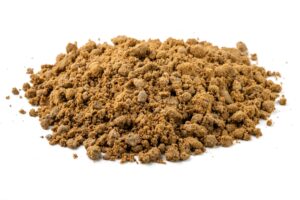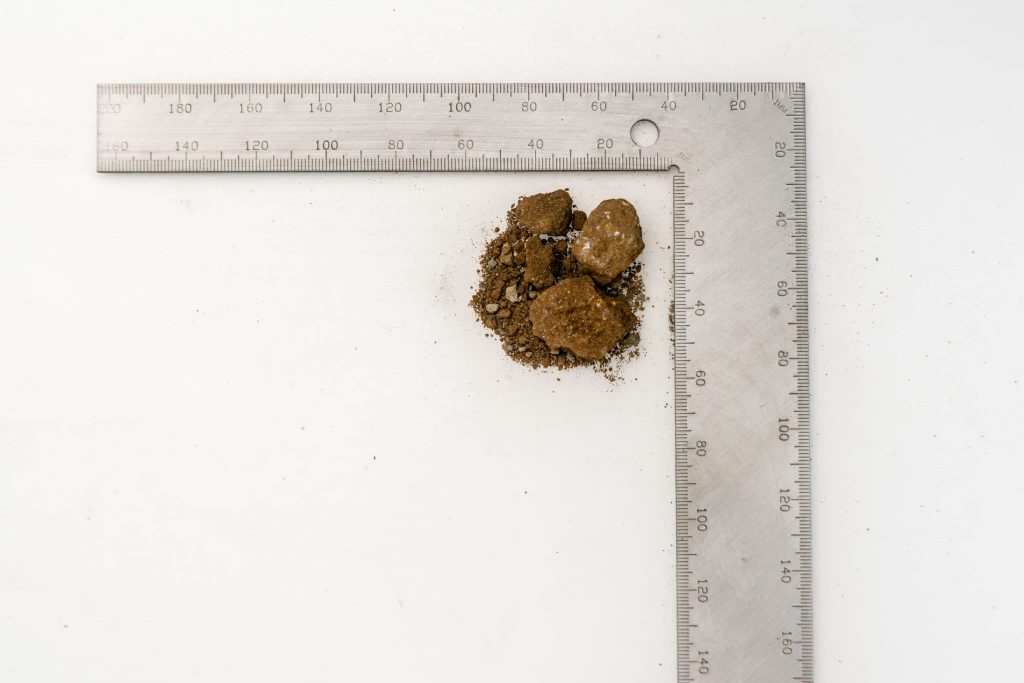Capping clay is a naturally occurring phenomenon in soil, and it is not deliberately applied; rather, it arises from the inherent behaviour of clay particles when subjected to moisture and compaction. When rain or irrigation water comes into contact with the soil surface, it causes fine clay particles to become suspended in the water. As this moisture subsequently evaporates, these particles settle down, giving rise to a dense and compacted layer or crust on the topmost surface of the soil.
This distinctive occurrence, known as “capping clay,” is characterized by the formation of a hardened cap or crust, primarily following episodes of rainfall or irrigation as the soil dries. Capping clay’s development can have significant implications for soil health, permeability, and the growth of plants, making it an essential consideration in various agricultural and gardening contexts. Understanding how capping clay forms and its potential impacts on soil quality is critical for effective soil management practices.
Applications
Capping clay serves a range of applications across construction, landscaping, and environmental management, often involving the application of a clay or clay-rich layer to accomplish specific goals.
Backfilling: Capping clay is employed in backfilling projects, which entail the placement of a clay or clay-rich material layer over the surface of backfilled soil. This practice is common in various construction scenarios, such as subdivisions and large commercial projects, where compactable materials are utilized beneath foundations to provide structural support and stability.
Foundation Support: In construction and civil engineering, capping clay can be strategically utilized to reinforce and provide additional support to the foundations of structures. This application ensures that the foundations remain stable and capable of withstanding the structural loads imposed upon them, contributing to the long-term integrity of buildings and infrastructure.
Landscaping: Capping clay can be integrated into landscaping projects to shape and sculpt the terrain. By applying a layer of clay-rich material, landscapers can create contours, embankments, and mounds that enhance outdoor spaces’ visual appeal and functionality. This application allows for creative landscaping designs and the development of unique outdoor environments.
Environmental Management: Capping clay plays a crucial role in environmental management efforts. It can be employed in soil capping systems designed to contain and isolate contaminants or hazardous substances in the soil, preventing their migration into groundwater or surface water. This application is significant in remediation projects, landfill management, and the restoration of contaminated sites.
Erosion Control: Capping clay can be a protective layer to mitigate soil erosion, such as slopes, embankments, or construction sites. By applying capping clay, the soil surface becomes more resistant to erosion caused by wind, water runoff, or other environmental factors, preserving the stability of the landscape.
Sealing and Waterproofing: Capping clay can serve as a sealing or waterproofing layer in construction and infrastructure projects. When correctly applied, it forms a barrier that prevents water infiltration or leakage, making it valuable in various water-related applications, such as pond lining, reservoir construction, or canal maintenance.
Agricultural Ponds: In agriculture, capping clay can be used in the construction and lining of ponds and irrigation reservoirs. It provides an impermeable barrier that helps retain water, ensuring a stable water supply for crop irrigation and livestock.
These diverse applications highlight the versatility and utility of capping clay in addressing specific needs across various industries, ranging from construction and landscaping to environmental protection and agricultural practices. The strategic use of capping clay can contribute to the successful execution of a wide array of projects and initiatives.
Benefits
Using capping clay provides several benefits across various applications, thanks to its unique properties and protective capabilities:
Reduced Erosion: Capping clay forms a protective cap that protects against the erosive forces of raindrops. By dispersing the energy of falling rain, it effectively minimizes soil erosion, safeguarding the topsoil from being washed away during heavy rainfall events.
Seedling Protection: In specific scenarios, the capping clay layer protects newly germinated seedlings. It shields them from the impact of raindrops, preventing potential damage or dislodgement of delicate young plants during their early growth stages.
Moisture Retention: While capping clay may limit water infiltration through its impermeable surface, it contributes to moisture retention in the soil beneath. This moisture-holding capacity proves beneficial, particularly during dry periods, as it ensures that the underlying soil remains adequately hydrated. Such conditions can be advantageous for plants with shallow root systems that rely on consistent moisture availability for healthy growth.
Weed Suppression: A capping clay layer can deter weed growth by acting as a physical barrier. This impedes weed seeds from reaching the soil surface, germinating, and establishing themselves. As a result, the need for weed control measures is reduced, promoting a weed-free environment.
Erosion Control: Beyond reduced erosion, capping clay aids in overall erosion control by stabilizing the soil surface. Its protective cap ensures the topsoil remains intact, preventing sediment runoff into nearby water bodies and preserving the landscape’s integrity.
Enhanced Seed Establishment: Capping clay can provide an ideal environment for seed establishment by protecting seeds from erosion, safeguarding them against adverse weather conditions, and maintaining consistent soil moisture. This contributes to successful seed germination and establishment of plant cover.
Improved Soil Quality: Over time, capping clay can enhance soil quality by contributing to better moisture management and reduced erosion. These factors promote improved soil structure and long-term fertility, benefiting natural ecosystems and agricultural endeavours.
Water Conservation: The moisture-retaining properties of capping clay contribute to water conservation efforts, particularly in regions with limited water resources. Minimizing water loss through surface runoff helps optimize water utilization for various purposes.
Protection of Sensitive Sites: In environmentally sensitive areas or locations with fragile ecosystems, capping clay is a protective layer that minimizes soil disturbance and helps maintain the ecosystem’s natural balance.
Enhanced Plant Survival: Capping clay’s moisture-retentive and erosion-reducing attributes support plant survival, especially in challenging environments with erratic rainfall or areas prone to soil degradation.
Improved Aesthetic Appearance: In landscaping and outdoor design, capping clay can contribute to the visual appeal of landscapes by creating smooth and well-maintained surfaces, enhancing the overall aesthetic quality of outdoor spaces.
Sustainable Land Use: The use of capping clay aligns with sustainable land management practices by reducing the environmental impact of soil erosion, promoting responsible land use, and conserving soil resources.
These multifaceted benefits underscore the practicality and effectiveness of capping clay in various applications, where it plays a pivotal role in preserving soil integrity, supporting plant growth, and protecting sensitive ecosystems.
Products
More like this

Type B Fill
Type B fill is frequently employed as a lightweight backfill material for constructing retaining walls and embankments, particularly in situations involving weaker soils. The term “Type B fill” designates a specialized category...

Type A Fill
Type A fill refers to a specific classification of engineered fill material commonly used in construction projects, providing a stable and compacted base for various structures.Type A material, known for its low permeability, is positioned...

Tailings
Tailings are the waste materials left behind after extracting valuable minerals from ores in industries like mining and mineral extraction. These residual materials consist of finely ground particles, often in a slurry form, and vary in...

Mud Stone
Mudstone is a type of sedimentary rock that is composed of fine-grained particles, including clay minerals and silt, derived from the settling of clay in calm water bodies. It forms through the accumulation and compaction of these small...

Clean Fill
“Clean fill” is a fundamental term in the construction industry, denoting earth materials, such as soil, rock, sand, gravel, or similar substances, that are devoid of contaminants, debris, or hazardous elements.

Clay Overburden
Clay overburden is the stratum of clay-rich material that frequently overlays valuable subterranean resources or mineral deposits. Typically, it is extracted and temporarily relocated during mining or excavation operations to facilitate...

Clay
Clay is a fine-grained soil material composed of minuscule mineral particles and organic matter. Its notable characteristic is its inherent plasticity and cohesion when in a moist state, while transitioning to a firm and compact form when...

Case
studies

Normark
Established in 1977, Normark are a second generation family business specialising in landscape design and construction across Melbourne. "From inner-city Melbourne courtyards to large commercial open spaces, Normark will deliver."

Normark
Established in 1977, Normark are a second generation family business specialising in landscape design and construction across Melbourne. "From inner-city Melbourne courtyards to large commercial open spaces, Normark will deliver."

Normark
Established in 1977, Normark are a second generation family business specialising in landscape design and construction across Melbourne. "From inner-city Melbourne courtyards to large commercial open spaces, Normark will deliver."

Normark
Established in 1977, Normark are a second generation family business specialising in landscape design and construction across Melbourne. "From inner-city Melbourne courtyards to large commercial open spaces, Normark will deliver."

Normark
Established in 1977, Normark are a second generation family business specialising in landscape design and construction across Melbourne. "From inner-city Melbourne courtyards to large commercial open spaces, Normark will deliver."



